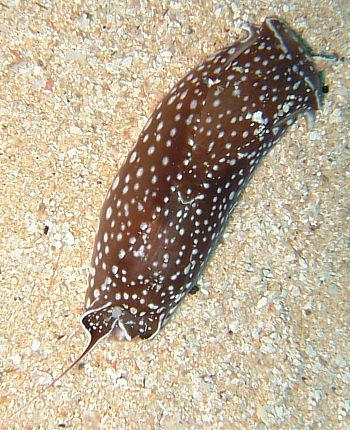
Aglaja tricolorata
Renier, 1807
Order: CEPHALASPIDEA
Family: Aglajidae
DISTRIBUTION
Known from the Mediterranean and the west coast of Africa.
PHOTO
Locality: Sliema, 32 m, Malta, Mediterranean, 3 June 2004, sandy bottom. Length: 4 cm. Photographer: Patricia Peels.
The identification of Aglaja tricolorata has a confused history, and although most authors now consider the animal illustrated here to be A. tricolorata, I have a slight doubt because some reports describe an orange and a blue line at the edge of the parapodia, which has certainly not been noted in any specimen which looks like the accompanying photograph. Until Martinez et al's anatomical study (1993) of aglajids from the Iberian Peninsula, our knowledge of this species was based on Vayssiere (1880 - as Doridium membranaceum) and copied by Pilsbry (1896) and Pruvot-Fol (1954).
- Martinez, E., Ballesteros, M., Avila, C., Dantart, L. & Cimino, G. (1993) The family Aglajidae (Opisthobranchia: Cephalaspidea) in the Iberian Peninsula. Iberus, 11(1): 15-29.
- Rudman, W.B. (1972) A comparative study of the genus Philinopsis Pease, 1860. (Aglajidae, Opisthobranchia). Pacific Science, 26(4): 381-99, 15 figs, 1 plate.
- Pilsbry, H. A. (1896) Manual of Conchology; Structural and Systematic. With illustrations of the species. Vol. XVI.' (Eds G. W. Tryon and G. W. Tryon.) p. 262. (Academy of Natural Sciences: Philadelphia.)
- Pruvot-Fol, A. (1954) Mollusques Opisthobranches. Faune de France, Paris 58: 1-460, Pl.1.
- Rudman, W.B. (1974) A comparison of Chelidonura, Navanax and Aglaja with other genera of the Aglajidae (Opisthobranchia, Gastropoda). Zoological Journal of the Linnean Society, 54(3): 185-212.
- Vayssière, A. (1880) Recherches anatomiques sur les mollusques de la famille des Bullides. Annales des Sciences Naturelles, (ser 6), 6(4): 1-123.
Rudman, W.B., 2007 (January 31) Aglaja tricolorata Renier, 1807. [In] Sea Slug Forum. Australian Museum, Sydney. Available from http://www.seaslugforum.net/find/aglatric
Related messages
Re: Aglaja tricolorata 'colour variation'
August 17, 2009
From: Dominique Horst
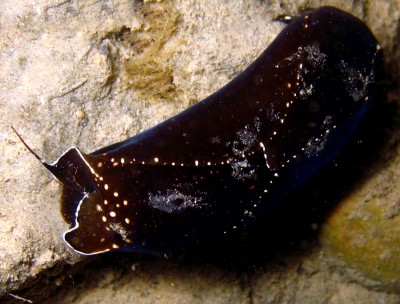
Concerning message #21856:
Hi Bill,
I think this specimen is Aglaja tricolorata showing a colour variation.
The tail is identical with the flagellum and the global shape also.
Would you confirm, or could this be Chelidonura sp ?
Locality: Cagnes, 8 m, France, Mediterranean sea, 17 June 2009. Length: 45 mm. Photographer: Dominique Horst.
Many thanks and kind regards,
Dominique
dominique.horst@wanadoo.fr
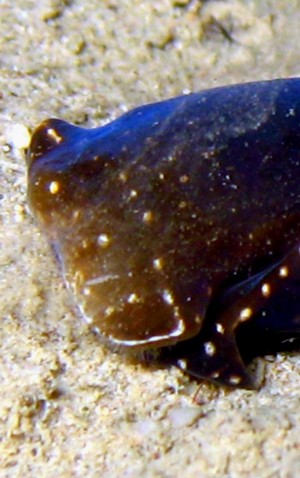
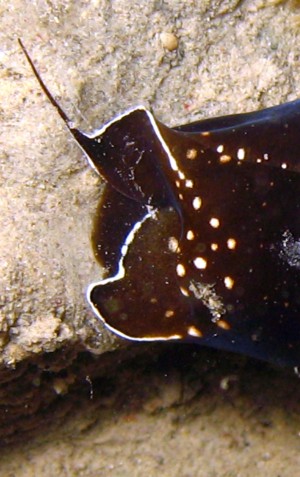
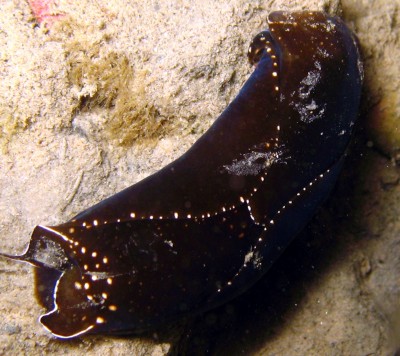
Dear Dom,
The thin flagellum is a good characteristic of Aglaja. Also the shape of the ridge on each side of the head shield - outlined in white in your photo - is very similar to the east Pacific species Aglaja ocelligera.
Best wishes,
Bill Rudman
Re: Aglaja tricolorata 'feeding'
September 5, 2008
From: Dominique Horst
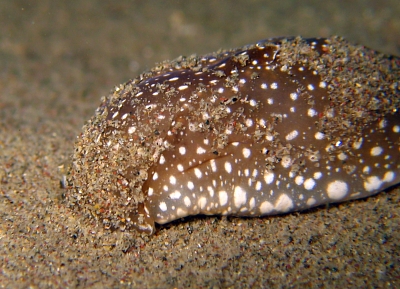
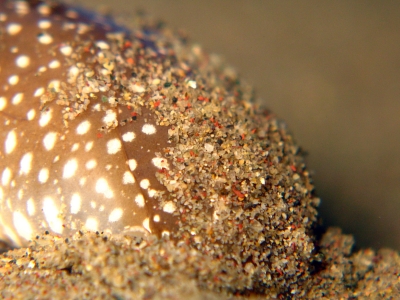
Concerning message #21709:
Hi Bill,
We had the chance to observe an Aglaja tricolorata feeding last night.
It push the sand as a snow-plow do with the snow, the sand over it's mantle and then fall on the border or even on the trail. The one we saw was very active in making a long convoluted trail.
Locality: Cagnes, 8m, France, Mediterranean sea, 29 August 2008, muddy. Length: 40 mm. Photographer: Dominique Horst.
Kind regards,
Dominique
dominique.horst@wanadoo.fr
Horst, D., 2008 (Sep 5) Re: Aglaja tricolorata 'feeding'. [Message in] Sea Slug Forum. Australian Museum, Sydney. Available from http://www.seaslugforum.net/find/21856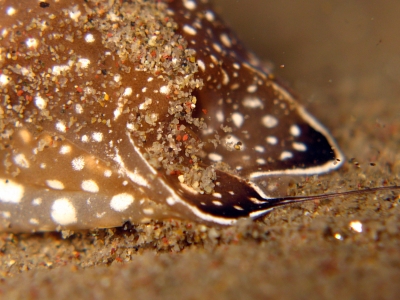
Dear Dom,
When I saw your message about seeing Aglaja feeding, my heart jumped, because I am pretty sure we still don't know what species of Aglaja actually eat. As a postgraduate student, many years ago, I studied feeding in this family and found species of Melanochlamys feeding on polychaete worms and some species of Philinopsis feeding on cephalaspidean bubble shells. We now have information [see messages on Chelidonura varians] suggesting that species of that genus feed on flatworms, and there is quite a bit of research showing Navanax inermis feeds on a wide variety of opisthobranchs, including bubble-shells, sea hares and nudibranchs. But I still thinking we are waiting for information on the food of species of Aglaja.
What your animals are doing is 'ploughing' through the upper layers of the sand, perhaps trying to find food by using the sensory bristles aglajids have on each side of the mouth. Aglajids have large mucus glands along the front of the foot which produce a continuous tube of mucus through which the animal crawls. Their whole body is covered with microscopic hairs or cilia which propel them through the mucus tube. This means that as they crawl along their organs don't get clogged up with the sand or mud through which they are crawling. The sandgrains you can see travelling up over the head and down off the 'tail' are attached to a thing mucus layer.
To return to what they eat. Perhaps you could try a little experiment and try putting possible food items in their path and see if they respond. The most likely would be a bubble-shell [Haminoea perhaps?], a nudibranch, a small flatworm and a polychaete worm.
Best wishes,
Bill Rudman
A damaged Aglaja tricolorata
September 4, 2008
From: Dominique Horst
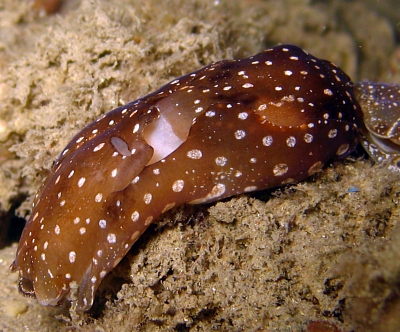
Concerning message #21676:
Hi Bill,
It seems that even Aglaja has repulsive chemicals to avoid aggression. This photo shows that even though a first bite can cause quite a lot of damage, the animal survives.
Locality: Cagnes, 4 m, France, Mediterranean sea, 29 August 2008, muddy. Length: 40 mm. Photographer: Dominique Horst.
Kind regards,
Dominique
dominique.horst@wanadoo.fr
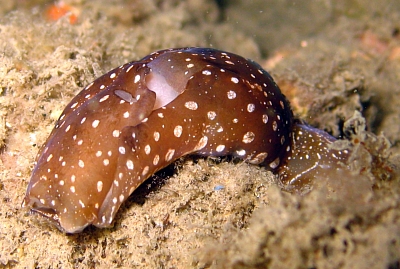
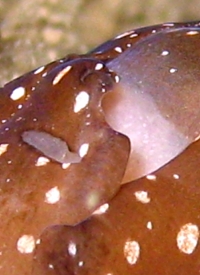
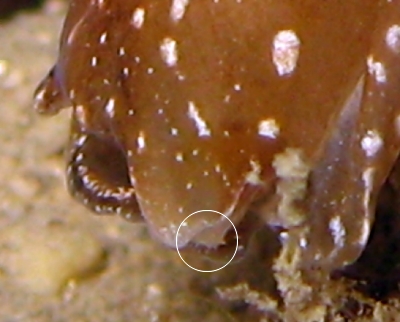
Dear Dom,
Thanks for the photos. Like most sea slugs, aglajids have skin glands which deter predators. Two other things I can note in your photos is that the animal is being 'trailed' by another [see your message #21709] and in the close-up alongside I can just make out the sensory bristles which are characteristic of aglajids and occur in clusters on each side of the mouth. They are most obvious in the genus Chelidonura [see C. hirundinina Fact Sheet].
Best wishes,
Bill Rudman
Aglaja tricolorata 'trailing'
July 17, 2008
From: Dominique Horst
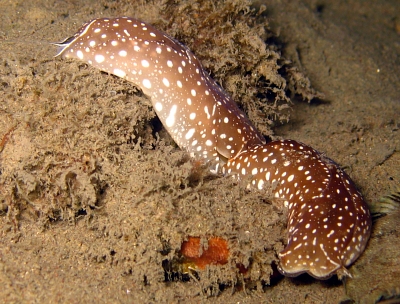
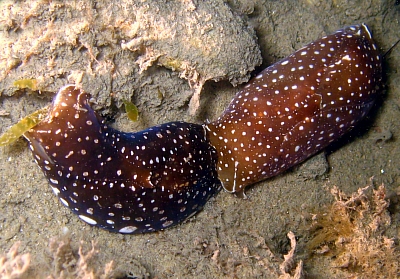
Concerning message #21676:
Hello Bill,
Still about Aglaja tricolorata. We have often see two individuals that have a particular behaviour. They are moving in a procession, one behind the other. Are they mating?
Usually in the couple, one has a dark colour and the other one is less dark.
Not sure this has any significance, but the behaviour is strange.
Locality: Cagnes, 8 m, France, Mediterranean sea, 15 July 2008, muddy. Length: 30 mm. Photographer: Dominique Horst
Kind regards,
Dom
dominique.horst@wanadoo.fr
Horst, D., 2008 (Jul 17) Aglaja tricolorata 'trailing'. [Message in] Sea Slug Forum. Australian Museum, Sydney. Available from http://www.seaslugforum.net/find/21709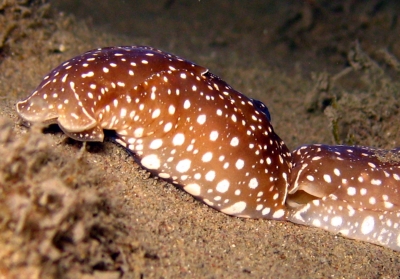
Dear Dom,
As I discuss on the Fact Sheet, manyy sea slugs exhibit this 'trailing' behaviour. There are photos of at least three aglajids doing this in Forum messages [ Chelidonura varians, Chelidonura inornata, Chelidonura punctata] and we know that Navanax inermis does as well. In all these cases there is no direct evidence of mating so all we can say is that they seem to be following the mucus trail of the lead animal.
There are also a couple of examples of the Forum of species of Chelidonura forming mating chains - Chelidonura livida [#8036] , and C. punctata [#16512], a behaviour similar to that observed in Sea Hares [see Mating Chains Fact Sheet]. I have personal experience of another aglajid, Melanochlamys cylindrica, forming mating chains, with up to 5 or 6 animals linking head to tail. This did not seem to be a normal behaviour but when groups of animals were kept in close proximity - in an aquarium or jar - they would quickly begin mating head to tail in long chains.
I can't see any evidnce of mating in your animals so I assume the 'follower' is just attracted to the lead animals mucus trail.
Best wishes,
Bill Rudman
Re: Aglaja tricolorata from the French mediterranean
July 7, 2008
From: Dominique Horst
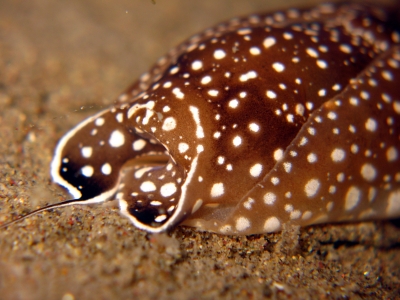
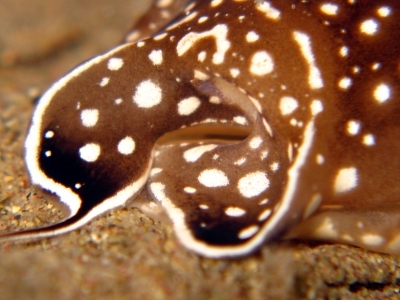
Concerning message #21672:
Hello Bill,
Many thanks for your quick answer.
I will now consider the physical colour. I was miles away from thinking about this...
As proposed, the close-up shots about the posterior flagellum.
Locality: Cagnes, 8m, France, Mediterranean sea, 01 July 2008, muddy. Length: 40mm. Photographer: Dominique Horst.
Kind regards,
Dom.
dominique.horst@wanadoo.fr
Horst, D., 2008 (Jul 7) Re: Aglaja tricolorata from the French mediterranean. [Message in] Sea Slug Forum. Australian Museum, Sydney. Available from http://www.seaslugforum.net/find/21676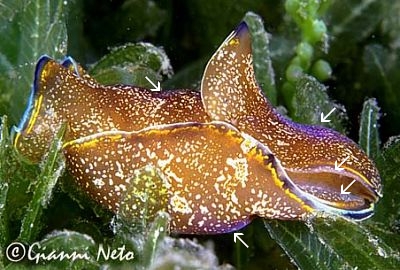
Dear Dom,
Thanks for the close-up photos of the flagellum. It's good to be able to compare it with similar structures in the closely related, if not identical genus Navanax.
Concerning the structural colours. You need to see living aniamls, not photos, to distinguish these structural colours because they are only seen, a bit like a rainbow, when you change the angle of your eye, or your light, to the animal's body. This 'false' blue is seen in other aglajids as well, and by chance we have a good photo of it in Gianni Neto's photo [message #5793] of that other mediterranean aglajid, Philinopis depicta. I have copied his photo alongside and have added arrows pointing to the blue bands which are caused by the interaction of light with the beating of the cilia covering the skin. The blue at the posterior tip of the head shield and the posterior edge of the body are pigment.
Best wishes,
Bill Rudman
Aglaja tricolorata from the French mediterranean
July 4, 2008
From: Dominique Horst
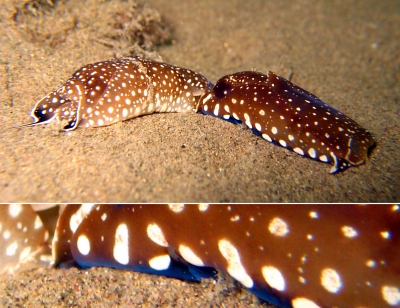
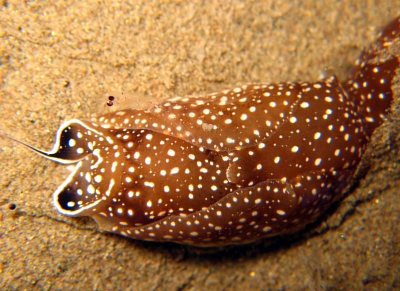
Concerning message #19319:
Hello Bill,
These Aglaja tricolorata are mating or supposed to be, even if they look quite different. In fact, one has a blue border line and the second doesn't.
I can also send to the forum, shots that show the detail of the posterior flagellum.
Locality: Cagnes, 8 m, France, Mediterranean sea, 1 July 2008, muddy. Length: 40 mm. Photographer: Dominique Horst.
Kind regards,
Dom.
dominique.horst@wanadoo.fr
Horst, D., 2008 (Jul 4) Aglaja tricolorata from the French mediterranean. [Message in] Sea Slug Forum. Australian Museum, Sydney. Available from http://www.seaslugforum.net/find/21672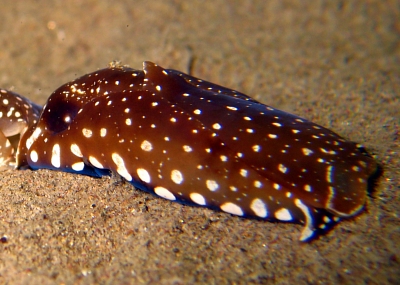
Dear Dom.,
Photos of Aglaja tricolorata are of special interest to me because one of my first research projects - 40 years ago - was on species of the family Aglajidae and the first problem was to sort out just how many genera there were. The biggest stumbling block was the lack of information on the mediterranean species Aglaja tricolorata on which the genus Aglaja was based. Adding to the confusion was the other mediterranean species 'Aglaja' depicta, which we now know belongs to the genus Philinopsis, which had been confused with A. tricolorata by some early workers and so we had no real idea of the anatomy of either species. Unfortunately I was unable at the time to borrow specimens of either species. It's only in recent years that I have at last seen good photos, like yours, of Aglaja tricolorata, which show the posterior flagellum, the pointed (almost tentacular) extensions to the anterior end of the parapodia, and the rounded posterior 'tip' to the head shield.
As to your question about colour differences. I think the blue band you can see is a not a pigment colour, but what we call a 'physical' colour caused by light being refracted through the fur-like layer of microscopic cilia which cover the surface of the skin. For some reason only blue light seems to be reflected, and can only be seen from certain angles. This blue sheen can be seen most clearly in darker animals which explains why you can see it in the dark brown specimen but not the light brown one. I would certainly like to add some close-up shots of the flagellum.
Best wishes,
Bill Rudman
Aglaja tricolorata from Malta
February 1, 2007
From: Patricia Peels
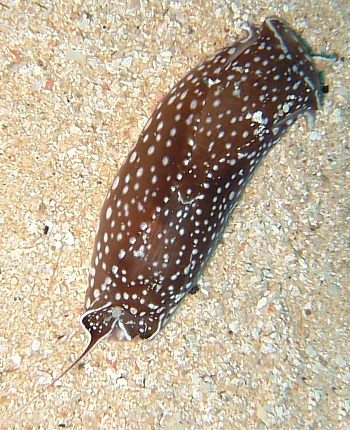
Concerning message #5416:
Hallo Bill,
While browsing through your website I came across your request for more pictures of aglajids from the Mediterranean. I'm attaching one which was taken a few years ago and identified as "Aglaja tricolorata Renier, 1807". Is this correct?
Locality: Sliema, 32 m, Malta, Mediterranean, 3 June 2004, sandy bottom. Length: 4 cm. Photographer: Patricia Peels.
Thank you for your help!
Patricia Peels
gmpeels@nextgen.net.mt
Peels, P., 2007 (Feb 1) Aglaja tricolorata from Malta. [Message in] Sea Slug Forum. Australian Museum, Sydney. Available from http://www.seaslugforum.net/find/19319
Dear Patricia,
Thanks very much for this photo of Aglaja tricolorata. When I revised this family in the 1970s it was very important to sort out the Mediterranean species, as the genus names Doridium and Aglaja were based on animals from there. Unfortunately the literature was quite confusing and it was not until quite recently that good descriptions have appeared. I must say however that the name of A. tricolorata [tricolorata (= three colours)] does make me wonder if we have misidentified this species, which is essentially dark brown and white.
The drawing alongside is a good example of the confusion. It is an illustration of Aglaja tricolorata from Vayssiere (1880 - as Doridium membranaceum) and was copied by Pilsbry (1896) and Pruvot-Fol (1954). The distinctive tentacular corners on the anterior parapodia are absent and the thin posterior flagellum is shown to originate from the top of the posterior shield when it in fact extends out from the ventral fold. The small dark specks are also misleading, as the animal is a dark translucent brown with opalescent white spots scattered all over the dorsal surface and the sides. On the ventral surface the background colour is much more translucent and the white spots larger. Some reports say there are blue and orange lines along the parapodial edge but that seems to be a confusion with Philinopsis depicta.
-
Pilsbry, H. A. (1896) Manual of Conchology; Structural and Systematic. With illustrations of the species. Vol. XVI.' (Eds G. W. Tryon and G. W. Tryon.) p. 262. (Academy of Natural Sciences: Philadelphia.)
-
Pruvot-Fol, A. (1954) Mollusques Opisthobranches. Faune de France, Paris 58: 1-460, Pl.1.
-
Rudman, W.B. (1974) A comparison of Chelidonura, Navanax and Aglaja with other genera of the Aglajidae (Opisthobranchia, Gastropoda). Zoological Journal of the Linnean Society, 54(3): 185-212.
-
Vayssière, A. (1880) Recherches anatomiques sur les mollusques de la famille des Bullides. Annales des Sciences Naturelles, (ser 6) 6(4): 1-123.
Best wishes,
Bill Rudman
